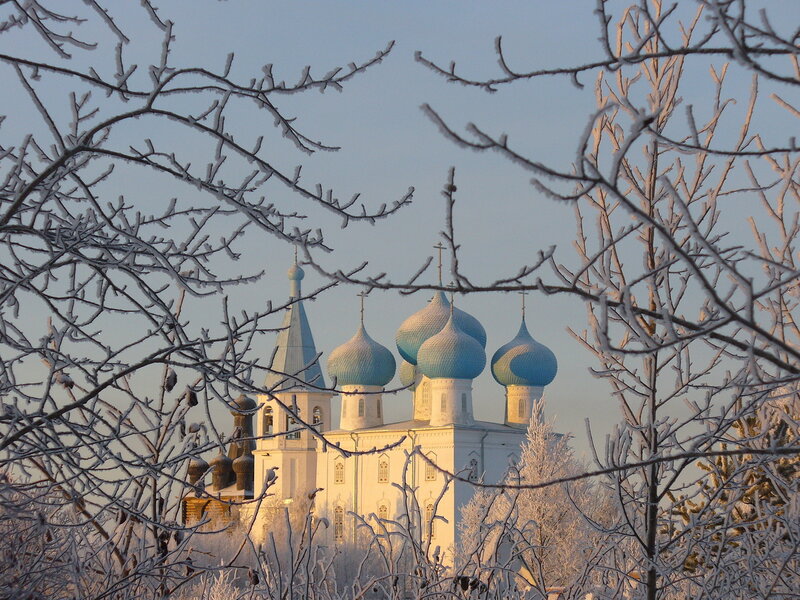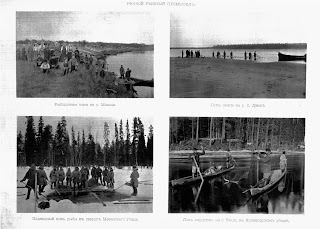From north to south the Region crosses three climatic zones – arctic, sub-arctic and moderate, the coastal line of 3000 km is washed by the White, Barents and Kara Arctic Seas.
Characteristic for the Region is a very dense and full-flowing network of rivers and numerous lakes, there are many mineral water deposits of medicinal value, picturesque and variable landscapes of the northern nature which has survived in its primordial state.
In the west the Region borders with the Karelia Republic, in the south – with the Vologda and Kirov Regions, in the east - with the Komi Republic and the Tyumen Region.
The Region area is 587 thousand square km. The population was 1.3 million people. The national structure of the Arkhangelsk Region population is comparatively homogeneous (Russians make 92 % of the population).
The population density is 2.5 per 1 square km. 75 % of people live in towns and cities, 26 % - in the country. The average age is 36 years old. The population capable of working makes 59 % of the whole number of people.
Territorially the Region comprises the Nenets Autonomous District, 20 administrative districts, 14 towns, 38 working settlements, about 4 thousand villages, as well as the islands of Novaya Zemlya and Franz Joseph Land.

Посмотреть на Яндекс.Фотках
The administrative centre of the Region is the city of Arkhangelsk, which was founded on the Tsar Ivan the Terrible’s order of March 5, 1584, in the mouth of the Northern Dvina River. The largest cities in the Region are Severodvinsk, Kotlas, Novodvinsk, Koryazhma.
Climate
Three climatic zones are observed in the territory of the Arkhangelsk Region – the arctic (the northern island of the Novaya Zemlya and Franz Joseph Land), sub-arctic (the Nenets Autonomous District, the Kolguyev and Vaigach Islands) and moderate ( the rest of the Arkhangelsk Region territory). Characteristic for the Region are moderately cold and long winter with much snow, cloudless spring, moderately warm summer, cloudy and rainy autumn. Annual precipitation increases from north to south: in average 27 % of precipitation is snow, 55 % is rain, and 12% is snow and rain.
White Nights Land
It is no mere chance that the Arkhangelsk Region is called the White Nights Land. From the middle of May and almost to the end of July to the north of Polar Circle the sun never disappears behind the horizon; to the south of Polar Circle days are much longer than nights, the latter resembling dawns. In winter the situation is vice versa - the territory to the north of Polar Circle sinks into darkness of a Polar night, in the south the sun rises but very low, and day lasts only 5 hours.
There are good grounds to believe that the first settlers in the North, primordial hunters and fishermen, came here 14 thousand years ago. The evidence of the fact is more than 800 archeological finds from Paleolithic to Middle Ages, material evidence of the settlements of legendary and mysterious Chud and Lope tribes along the Vaga, Pinega, Mezen rivers and on the Lake Lache.
In the 8th century the first groups of Slavs from Rostov-Suzdal and Novgorod areas came to the North. They brought land-cultivating, written language, Christianity with them. From here the Slavs-farmers went to sea and found sea routes to Scandinavia and Siberia; here an original culture of the Pomors formed and it was here that the Russian fleet was destined to be born and the famous ‘three-coloured’ flag to be hoisted.
Quite a special place in developing the area belongs to Russian Orthodox escetics and monasteries. In the 12th-15th centuries there already appeared first cloisters, by the 17th century there had been about 60 monasteries which had become cultural centres and safeguards of the northern borders of the Russian State. The monasteries actively used the latest achievements in engineering, promoted ancient Russian arts. Hundreds of talented icon painters, golden-stitch embroiderers, scribes, jewelers, smiths worked in the monastery workshops.
In the 18th century when the centre of external economic activities in Russia moved to the Baltic region the tempo of social and economic development of the Arkhangelsk North reduced; in the process of becoming a Russian province, nevertheless, the region preserved its original colour, traditions and unique historical and cultural heritage of the Russian northerners.

«ВИД С КОЛОКОЛЬНИ» на Яндекс.Фотках
The Pomors are a distinctive self-name (ethnonym) of the native ethnicity in the European North of Russia (Pomorye). The ethnonym ‘pomor’ (derived from the words ‘po moryu’ by the sea ) appeared not later than in the 12th century on the southwest (Pomorsky) coast of the White Sea, and in the 14th - 16th centuries it spread far to the south and east from the place of its origin. Ethnogenesis of the Pomors was a result of two cultures merging: of the proto-Pomor, mainly Finno-Ugric tribes (of Chud people) living on the coast of the White Sea and of the first Russian colonists actively populating the areas in Zavolochye.

In the 12th - 15th centuries the Pomorye area was a colony of the Great Novgorod. In the 15th - 17th centuries the Pomorye was a geographic name for a large economic and administrative territory along the coast of the White Sea, of the Onega Lake and along the Onega, the Northern Dvina, The Mezen, the Pinega, the Pechora, the Kama, the Vyatka rivers and up to the Urals. By the beginning of the 16th century Pomorye was annexed by Moscow. In the 18th century the 22 ‘uyezds’ of Pomorye were mainly populated by free ‘black wooden plough’ peasants. In the 19th century Pomorye was called the Russian North, the European North of Russia, etc. Later the term ‘Pomorye’ was ‘eroding’, the general term ‘severyane’ (the Northeners) supplanted the ethnonym ‘Pomors’; in spite of the active processes of assimilation of the Pomors by the Great Russian ethnos (ethnonym ‘Great Russian’ appeared in the 19th century) they have preserved their ethnic (national) identity to this day. The evidence of the fact is the result of the All-Russia Census of 2002 – many people defined their nationality as that of the Pomor (Census Register Code № 208 - «nationality - Pomor»).

The evidence of the ethnic entity of the Pomors is their ethnic (national) identity and a self-name (ethnonym ) ‘Pomors’, common historical territory (Pomorye), common culture and common language (the Pomor ‘govorya’- from the word ‘govorit’ – to speak), ethnic (national ) character, ethnic religious ideology (the Pomorskaya Ancient Russian orthodox Church), common traditional economy and other factors.

Sources:www.nashkraysev.ru,www.pomorland.info


2 комментария:
Lastochka,
I'm sorry for my ignorance, but I was wondering about the white nights-first i thought it's only around St Petersbourg and then I saw the dance film called White Nights with mixhail Baryshnikov (the dancer) and they say in siberia there are white nights - can it be?
This blog is wonderful, simply wonderful, please carry on!
Simone
Tnank you very much!)))))))Welcome to my blog))
It depends on geografical situation of the region.For example, it's also possible to enjoy the white nigths in the next cities:Cherepovets (Vologda region), Vologda, Berezniki (Siberia-perm region),Magadan ( the Far East),Nizhevatorsk ,Hanty-mansiisk,Nadym,Surgut, Syktyvkar,Lensk,Yakutsk,Uhta,
Pechora (Siberia), Arghangelsk,Severodvinsk, Usinsk.
But it's duration differs much depends on region.
Отправить комментарий